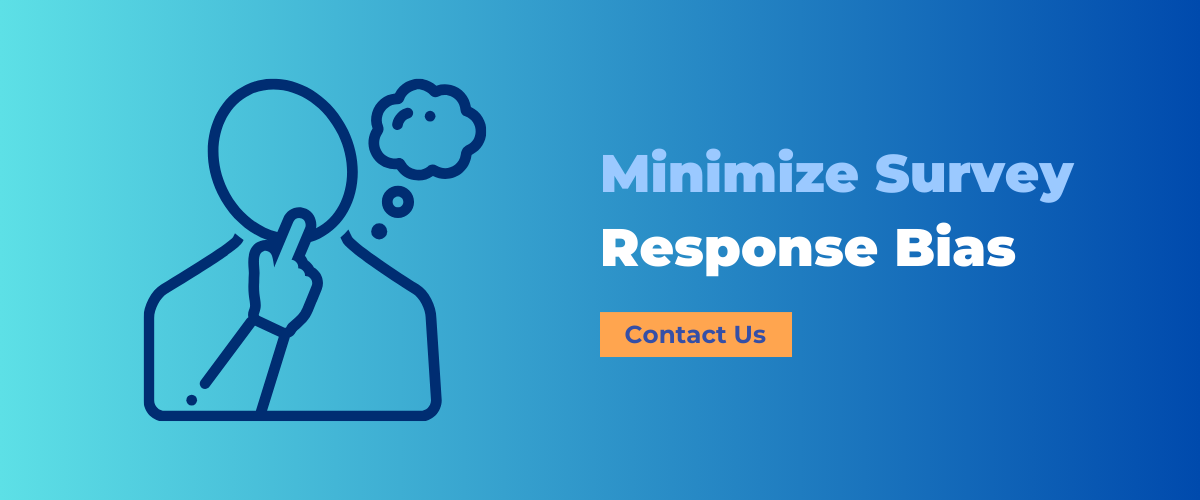Looking for new insights to inform your company's decision-making? Survey-based research is a...
10 Types of Survey Response Bias and How to Minimize Them

Surveys are powerful tools for collecting valuable data and insights, but they are susceptible to various forms of response bias that can compromise the accuracy and reliability of the data. In this post, we’ll explore several types of survey response biases and strategies to combat them to enhance the validity of your research.
What is Survey Response Bias?
Survey response bias is any bias that skews respondents to answer in a way that is different than how they truly feel. Minimizing this bias is crucial to ensuring the data collected accurately represents the survey sample.
Survey Response Biases & Tips to Minimize Them
Our previous post on minimizing survey bias covered both selection bias and response bias. Below, we recap those and discuss additional types of response bias. While this list is not exhaustive, it does provide a basis for identifying and mitigating response bias in your quantitative research studies.
1. Social Desirability Bias
Social desirability bias, also known as conformity bias, occurs when respondents provide answers they believe are more socially acceptable instead of their true feelings. They tend to downplay undesirable attitudes while inflating more desirable opinions or attributes. For example, on a question about recycling, they may choose to say they always recycle (socially acceptable behavior) instead of never recycling (their actual behavior).
Best practices:
- Explicitly let respondents know their responses will only be used in aggregate and will not be tracked back to them.
- Phrase questions in a way that reduces judgment or stigma.
- Emphasize the importance of honest responses.
- Do not ask for personally identifiable information.
2. Acquiescence Bias
Acquiescence bias, also known as the “yes” bias, occurs when study participants tend to agree with survey statements or questions, regardless of their actual beliefs. This is often because some people find agreeing more comfortable than stating a conflicting opinion.
Best practices:
- Randomly mix positively- and negatively-worded questions to minimize the tendency to fall into a pattern of agreement.
- Use an answer scale range that allows for a range of answers instead of yes/no.
- Try reverse-worded questions to encourage respondents to think more critically about their answers and reduce the tendency to agree with everything.
- Emphasize the desire for the research to reflect the respondent’s honest feelings on the topic.
3. Extreme Response & Central Tendency Bias
Extreme response bias occurs when respondents consistently select extreme response options (e.g., “strongly agree” or “strongly disagree”) without considering question nuance. This can potentially lead to overrepresented extreme viewpoints.
Central tendency bias, on the other hand, occurs when respondents habitually choose middle-of-the-road options (e.g., “neither agree nor disagree” or “neutral”), leading to reduced response variation.
Best practices:
- Provide a balanced and well-structured response scale with an even distribution of positive and negative options.
- Avoid emotionally charged language that may inadvertently influence responses.
- Rotate the order in which questions are presented to prevent respondents from getting into the habit of selecting the same position on the scale for every question.
- Include anchors or examples to help respondents better understand the meaning of the response options to reduce the possibility of confusion or misinterpretation.
4. Nonresponse Bias
Nonresponse bias can occur when specific demographic groups are less inclined to participate. If the non-responders differ greatly from your study population, the survey results may not accurately represent the entire population.
Best practices:
- Employ random sampling techniques to ensure a representative sample.
- Implement strategies to increase response rates, such as personalized invitations, multiple survey channels, and incentives.
- Analyze and adjust for nonresponse by applying statistical techniques such as post-stratification or weighting when applicable.
5. Question Order Effects
Responses can be influenced by the order in which questions are presented. Survey participants may be more likely to agree with later questions if earlier questions have primed them to do so, or vice versa.
Best practices:
- Randomize question order where possible.
- Use counterbalancing techniques to present groups of questions in different sequences to different respondents.
- Start with neutral or general questions as a warm-up to help respondents get comfortable before they encounter more specific or sensitive questions.
6. Answer Order Bias
Answer order bias occurs when people do not take the time to read through all of the answer choices and instead choose from only the first few options. This can be a result of speeding, where respondents choose the first answer they agree with to get through the survey as quickly as possible. It can also be the result of survey fatigue.
Best practices:
- When possible, trim the list of answer options.
- Randomize radio button answer series so each respondent is presented with answer choices in a different order.
- Apply skip logic in your survey programming to ensure respondents only see relevant questions.
- Critique the length of your questionnaire to avoid survey fatigue.
7. Sponsorship Bias
Sponsorship bias occurs when a respondent knows who commissioned a survey and, as a result, their feelings about the sponsor influence their responses to individual questions.
Best practices:
- Do not include brand or logo information anywhere on the invitation, survey form, or other materials.
- Check your survey link to ensure no brand information appears in the URL.
- Provide a neutral introduction to the survey.
- Use a third-party research firm to conduct the study.
8. Halo Effect
The halo effect occurs when a respondent has a positive or negative experience with a single attribute that influences their appraisal of other attributes. For example, if someone’s food is cooked poorly at a restaurant and they later receive a survey asking about price, restaurant cleanliness, and staff service, they may score all attributes low. In this case, the halo effect created a negative generalization of their entire dining experience.
Best practices:
- Remember that everyone is prone to biased thinking, and prepare to account for this in your data analysis.
- Consider asking questions about specific attributes before questions about the overall experience.
- Maintain a neutral and unbiased tone throughout the survey.
- Avoid providing unnecessary context or extraneous information that could influence respondents’ perceptions.
9. Recall Bias
Many individuals struggle to accurately recall past events or experiences, leading to inaccuracies in their responses. Recall bias is most common in surveys that rely on respondents’ memory, such as retrospective or longitudinal studies. Memory degradation is more pronounced the further the respondent is from the event.
Best practices:
- Shorten the timeframe for respondents to recall information by asking about more recent events when possible (such as “last trip” instead of “average visit”).
- Use memory aids, prompts, or reference points to help respondents recall information accurately.
- Incorporate verification questions to prompt respondents to validate or clarify their previous responses.
10. Volunteer Bias
As you might expect, volunteer bias occurs when respondents voluntarily choose to participate in a survey, which could lead to a non-representative sample. People with stronger opinions or experiences may be more likely to participate, potentially skewing the results.
Best practices:
- Ensure your sampling method is as random as possible while still being representative of your target audience.
- Use incentives strategically to motivate only respondents with the right experience in the topic.
- Analyze the characteristics of respondents and non-respondents to assess potential bias.
5 Additional Tips to Minimize Survey Response Bias
- Continuously monitor for response bias during data collection and analysis. Once you recognize bias and where it is occurring, you can properly account for it in your results.
- Follow best practices in survey design, including clear and concise language.
- Employ mixed methods or triangulation with multiple sources of data to validate survey findings.
- Use statistical techniques like weighting to adjust for known biases in your sample during data analysis.
- Seek input and review from experts in survey design, such as those at IntelliSurvey, to identify and address potential sources of bias.
How IntelliSurvey Can Help
Surveys are valuable tools for gathering insights and data, but the presence of survey response bias can undermine the integrity of the collected information. IntelliSurvey can help reduce the introduction of bias in your market research endeavors through thoughtful survey design, field management, and data analysis. Contact us for your next survey so we can work together to help you collect accurate data and insights.



